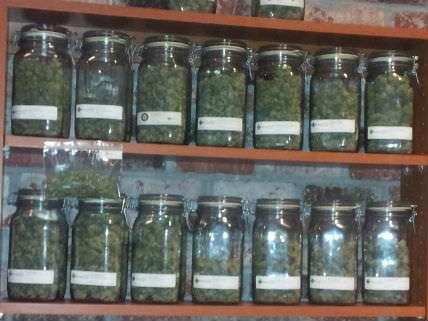Pediatrician Group Says Marijuana Should Be Reclassified
The American Academy of Pediatrics wants to see more study of the plant's medical uses.

In a policy statement published today, the American Academy of Pediatrics (AAP) reiterates its opposition to marijuana legalization but endorses decriminalization of possession and calls for the drug's reclassification under the Controlled Substances Act to make medical research easier:
The AAP strongly supports research and development of pharmaceutical cannabinoids and supports a review of policies promoting research on the medical use of these compounds. The AAP recommends changing marijuana from a Drug Enforcement Administration schedule I to a schedule II drug to facilitate this research.
That change, which could be carried out by Congress or by the executive branch, would move marijuana out of a category supposedly reserved for drugs with a "high potential for abuse" that have "no currently accepted medical use" and are so dangerous that they cannot be used safely, even under a doctor's supervision. Drugs in Schedule I, which also includes heroin and LSD, cannot be legally used for any purpose. Schedule II, the new category suggested by the AAP, includes prescription drugs such as morphine, oxycodone, cocaine, and methamphetamine, which are viewed as having high abuse potential but legitimate medical uses.
The AAP joins the American College of Physicians in urging a review of marijuana's legal status. Over the years the Drug Enforcement Administration (DEA) has repeatedly rejected petitions to reschedule marijuana, most recently in 2011. But as The Wall Street Journal notes, the Food and Drug Administration "is conducting an analysis—at the request of the DEA—to determine whether marijuana should be downgraded." Attorney General Eric Holder, who has the statutory authority to reschedule marijuana without new legislation from Congress, has said whether marijuana belongs in the same category as heroin is "certainly a question that we need to ask ourselves." A federal judge in California is considering that question as a result of a challenge brought by marijuana growers in a criminal case I discussed last fall.
Reclassifying marijuana would not automatically make it available as a medicine, but it would have several salutary effects, especially if marijuana is placed in Schedule III or lower. Facilitating research is one possible benefit, although if that is the aim rescheduling should be accompanied by the abolition of the federal government's monopoly on the legal supply of cannabis for research. The AAP does not mention that change, but it makes sense in light of the organization's position that marijuana derivatives should be treated like any other drug considered by the FDA.
In the meantime, are patients who can benefit from marijuana simply out of luck? The AAP seems ambivalent on that question. "The AAP opposes 'medical marijuana' outside the regulatory process of the US Food and Drug Administration," it says. But at the same time, "the AAP recognizes that marijuana may currently be an option for cannabinoid administration for children with life-limiting or severely debilitating conditions and for whom current therapies are inadequate." That means "a pediatrician may recommend marijuana for compassionate medical purposes, on a case-by-case basis, using anecdotal information."
Although the AAP opposes legalization of whole-plant marijuana for medical use, it concedes that the policy, contrary to warnings from drug warriors, has not been accompanied by a rise in underage consumption. "Since legislation allowing medical marijuana took effect across a number of states," the group notes in a technical report accompanying its policy statement, "there have been no significant increases or decreases in youth use rates [as measured by the Youth Risk Behavior Survey], with the exceptions of Alaska [which saw a decrease] and New Mexico….When all high school data are combined for each state in which medical marijuana is legalized and for which data for current use before and after medical marijuana legalization are available (14 states to date), no state with legalized medical marijuana has shown a statistically significant increase in adolescent recreational marijuana use except Delaware; 2 states (Alaska and Montana) have shown statistically significant decreases."


Show Comments (13)